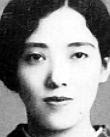1899
-
Takajo Mitsuhashi
 Mitsuhashi Takajo
Mitsuhashi Takajo(24 January 1899 – 7 April 1972)
One of the great Japanese haiku women poets Mitsuhashi Takajo was born on 24 January 1899 near Narita, Chiba. She was a haiku poet of the Shōwa period. She was an admirer and disciple of Akiko Yosano. She got married in 1922 and started writing haiku under the influence of her husband, but then later turned to experimental haiku along with other women poets. By 1936 she became part of a group that founded the short-lived Kon (dark blue) publication and in 1940 had the collection Himawari or Sunflowers published. In 1953 she became involved in Bara (薔薇, dt. "Rose") - a progressive magazine of avant-garde poets who allowed experimental haiku. She has been referred to as a religious ascetic or one who led a life of asceticism and spiritual concentration. She is said to have written works of self-alienation of the vanishing of the empiric Ego in the Void, which according to Kenneth Rexroth “resembles Kierkegaard’s rather than the Buddhist concept.” A statue of her is at Shinshoji Temple. Back in 1964, Blyth, in his History of Haiku, identified her as "the chief woman writer of haiku in Japan."
Her last collection, in 1970, dealt somewhat with death as she had been ill for years.
She is also placed as one of the "4 Ts" of Japanese female haiku poets, the other three being Tatsuko Hoshino, Nakamura Teijo, and Hashimoto Takako.
She died on 7 April 1972.
Haiku collections:
- Himawari (向日葵, dt. "Sunflower") in 1940;
- Uo no hire (Fins of a Fish)
- Hakkotsu (白骨, dt. "The Bleached bones") in 1952;
- Shida-jigoku (歯朶地獄, dt. "The Fern Hell") in 1961;
- Buna (ぶな, dt. "Beech"), 1970.
Selected work:
climb this tree
and you'll be a she-devil
red leaves in the sunset glow
up on a hydro pole
the electrician turns
into a cicada(Far Beyond the Field: Haiku by Japanese Women, by Makoto Ueda, Columbia University Press, 2003, pp.109-110)
*
winds of autumn -
water less transparent
than the fins of a fish(Haiku Mind, Patricia Donegan, Shambhala Publications. 2008, p.195)
*
O bird’s singing!
The dead walk
on the plain of the sea.
The hair ornament of the sun
has sunk
into the legendary sea.(Women Poets of Japan by Ikuko Atsumi; Kenneth Rexroth, New Directions, 1977, p. 80)
*
春水のそこひは見えず櫛沈め 三橋鷹女
shunsui no sokoi wa miezu kushi shizume
not able to see
spring water’s bottom…
I sink my comb(from “Haiku Dai-Saijiki” (“Comprehensive Haiku Saijiki”), Kadokawa Shoten, Tokyo, 2006)
*
口中一顆の雹を啄み火の鳥や
Kōchu ikka no hyō wo tsuibami hi no tori ya
A hailstone held
in its beak,
the firebird soars(From Mitsuhashi Takajo Zenkushū (Collected Haiku of Mitsuhashi Takajo, 1976)
*
老いながら椿となつて踊りけり
oinagara tsubaki to natte odorikeri
as I get older
I will become a camellia
and dance and dance秋の蝶です いつぽんの留針です
aki no choo desu ippon no tomebari desu
I am an autumn butterfly
I am just one pin(Tr. Gabi Greve)
Sources:
- http://wkdhaikutopics.blogspot.co.uk/2007/03/mitsuhashi-takajo.html
- https://en.wikipedia.org/wiki/Mitsuhashi_Takajo
- http://www.hsa-haiku.org/frogpond/2009-issue32-3/essay.html
- http://www.haikuworld.org/books/farbeyond.review.html
- https://translate.google.co.uk/translate?hl=en&sl=de&u=https://de.wikipedia.org/wiki/Mitsuhashi_Takajo&prev=search
- http://omamorifromjapan.blogspot.co.uk/2011/08/terifuri-ningyoo-weather.html
- http://www.japannavigator.com/2011/07/haiku-stones-in-kanto-mitsuhashi-takajo.html
- https://fayaoyagi.wordpress.com/2016/04/14/todays-haiku-april-14-2016/
- http://bungeikan.jp/international/detail/10/
- Mitsuhashi Takako zenshū (Rippū Shobō, 1889), vol. 2, pp. 203-207;
- Hashimoto Takako, Mitsuhashi Takako shū (Asahi Shimbunsha, 1984), pp. 33-336;
- Women Poets of Japan by Ikuko Atsumi; Kenneth Rexroth, New Directions, 1977, p. 80; p.153;
- Haiku Mind, Patricia Donegan, Shambhala Publications, 2008, p.195.
